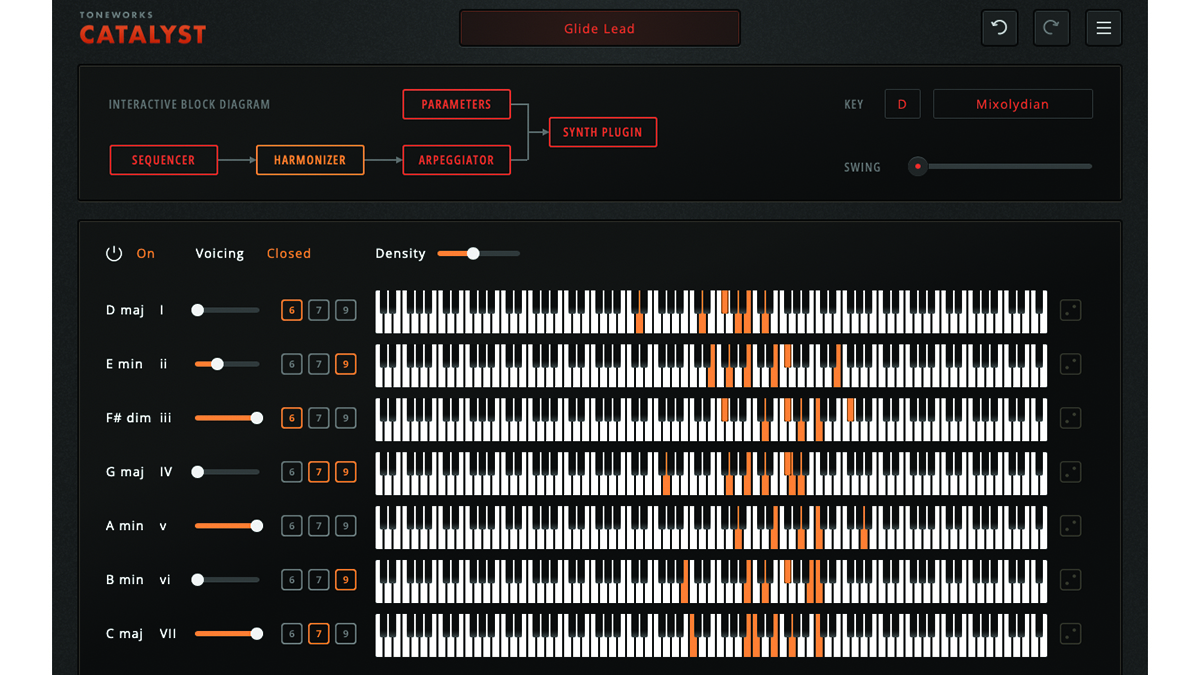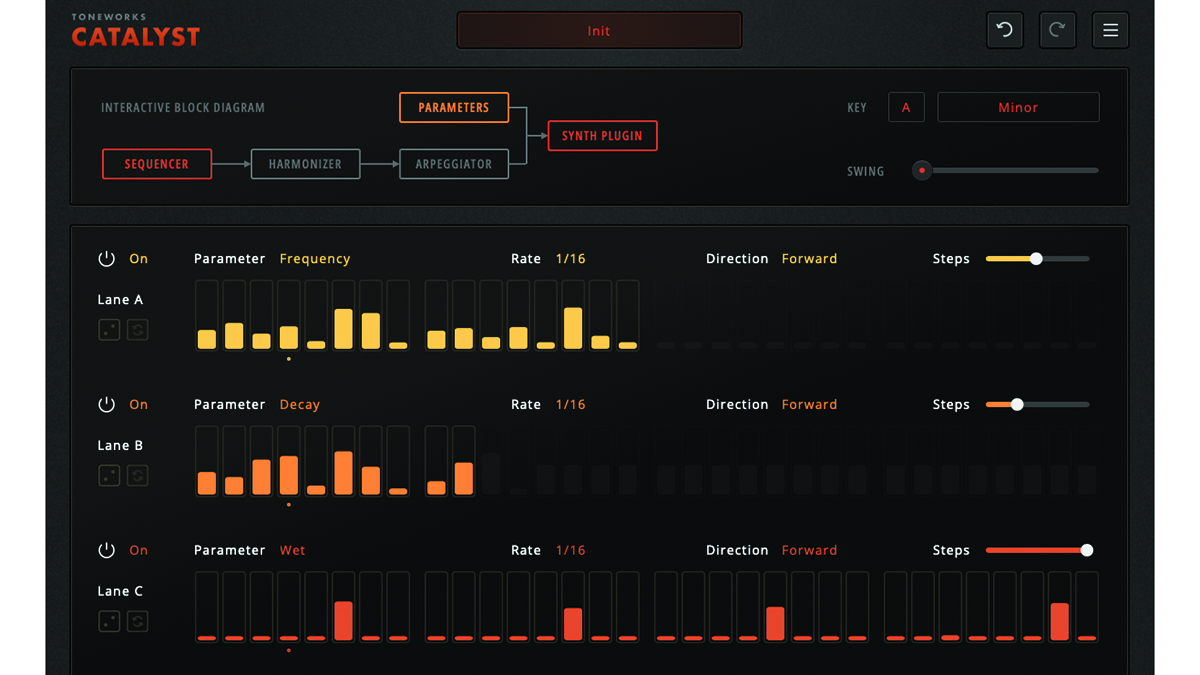MusicRadar Verdict
A fun, fast and intuitive sequencer that’s a few updates short of absolute greatness.
Pros
- +
Quick and fun sequencing.
- +
Hosting synths speeds up workflow.
- +
Helps generate unique ideas.
Cons
- -
No per-step probability.
- -
Only three parameter lanes.
- -
No MIDI drag-and-drop.
MusicRadar's got your back
Toneworks Catalyst: What is it?
Danish company Toneworks brings a fresh take on the humble step sequencer with its first product release, Catalyst.
It’s a flexible programming tool with a 32-step sequencer, harmonizer, and arpeggiator. However, its unique trick is the ability to host VST or AU instrument plugins, thus saving time with MIDI routing headaches. You can also sequence synth parameters directly in the plugin, leading to some complex and intricate-sounding patterns.

Toneworks Catalyst: Performance and verdict
The first thing to do when you load Catalyst, is to scan your plugin folder for VST/AU instruments. Once fully scanned, you can select the Synth Plugin page and choose an instrument from the list. We opened an instance of u-he’s Diva, which filled the lower portion of the GUI and didn’t quite fit our screen. Thankfully you can resize the GUI, from 40% to 150%.

• Audiaire Zenith
Customisable UI, great modulation options, and CC/SysEx functionality (to let you control other synths).
• Devicemeister Stepic
No plugins, but you do get features like eight lanes of CC modulation and per-note probability.
The next step is to choose a root note and key to work in. Options include major/minor, Dorian, Phrygian, Lydian and Mixolydian modes, and harmonic and melodic major and minor.
You can now draw some notes in the Sequencer module. Rather than semitones, the note divisions are degrees of the scale, so anything you input stays in key. You also have sequencer lanes for velocity and gate time, and buttons along the bottom to select if a note is played or not.
All four rows have a randomise button on the left, with the ability to select a maximum/minimum range for more controlled results.
Once you have a sequence, you can highlight selections and move groups of values, copy and paste, and shift the values left and right. There’s also a slider to select from 1 to 32 steps, which affect all lanes at once, so you can’t create more organic variations by having different lengths for the velocity and gate time.
Want all the hottest music and gear news, reviews, deals, features and more, direct to your inbox? Sign up here.
Further controls at the top allow you to change the sequence rate, octave and direction, with six options. You can also program up to five patterns, which you can switch between using the black keys on the keyboard, and then transpose using the white keys.
This makes for a simple but effective way to perform your patterns and try out different variations whilst staying in your chosen key. Overall, it’s simple but effective editing, although it would be nice to have a probability amount affecting whether a note will play or not.
Mind that tone
After the Sequencer we come to the Harmonizer, which creates full chords from single notes. It plays the seven fundamental chords from the selected key, and you can choose to add 6th, 7th or 9th notes to each chord, change the inversion, or add additional notes above and below by increasing the Density slider. This then feeds into the programmable Arpeggiator, which is similar in layout to the Sequencer in that you have up to 32 steps, and pitch, velocity and gate lanes.
There’s also the Chord memory function that essentially works like a latch, and a Repeat function that plays each step twice. Both of these modules have Randomise buttons so you can quickly generate new chord shapes and arp patterns at the click of a button.
As each module can be switched on/off, you could just use Catalyst as a simple sequencer or programmable arpeggiator, or you could use it with a keyboard as a one-note chord-triggering tool. However, the real magic comes when you combine all three.
You could program a fairly simple and sparse sequence over 32 steps that feeds into the Harmonizer to generate a more complex chord progression, and then add the arpeggiator to create exotic-sounding, sweeping melodies that you’d never dream of simply using a piano roll. You can then experiment with changing the key or elements in a single module to see how it affects the rest.

Parameter modulation
Alongside hosting instruments, one of the most unique features is the ability to modulate up to three parameters using three independent lanes in the Parameter module. You simply map which dials or sliders you want to control on the Synth page, and you’re good to go.
It’s an easy way to breathe unique life into any sequence, especially on synths that don’t have much built-in modulation. You could also choose to modulate uncommon parameters like the reverb amount or delay time for more unusual details.
That said, only having three lanes feels a little limiting, and (as of writing) you can’t then automate any other synth parameter in your DAW. You could try routing the MIDI output of Catalyst to an external synth, or use the useful MIDI FX version in Logic.
The only caveat here being that the parameter sequence page is greyed out. Hopefully, this can be reinstated along with CC control in a future update, alongside the much-requested MIDI sequence drag and drop for copying patterns to your arrange page.
Verdict
Catalyst is a fun, well-designed sequencer plugin with unique features that encourage you to generate interesting and complex-sounding patterns.
There’s still room for improvement, but it’s a good first version and we look forward to seeing where Toneworks takes it next.
MusicRadar verdict: A fun, fast and intuitive sequencer that’s a few updates short of absolute greatness.
Toneworks Catalyst: Hands-on demos
MusicRadar
Toneworks
Rezzonator – Electronic Music, Tips,Tricks,Reviews
MusicGearz
Emlyn In The Mix
Toneworks Catalyst: Specifications
- Windows 10 or higher.
- MacOS 10.12.6 (Sierra), MacOS 10.13.6 (High Sierra), MacOs 10.14.6 (Mojave), MacOS 10.15.7 (Catalina), MacOS 11.7.4 (Big Sur), MacOS 12.6.3 (Monteray) or MacOS 13.2.1 (Ventura). Apple Silicon (M1/M2) and Intel processors supported.
- 64-bits only.
- Any VST, VST3 or AU compatible host.
- CONTACT: Toneworks
Computer Music magazine is the world’s best selling publication dedicated solely to making great music with your Mac or PC computer. Each issue it brings its lucky readers the best in cutting-edge tutorials, need-to-know, expert software reviews and even all the tools you actually need to make great music today, courtesy of our legendary CM Plugin Suite.

